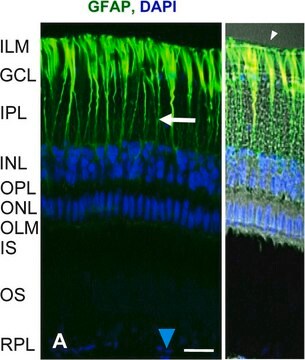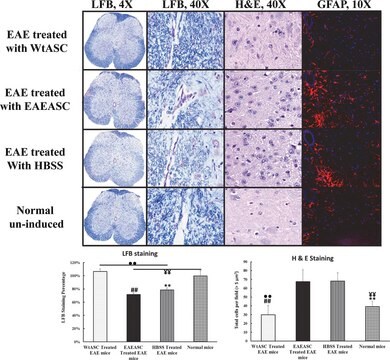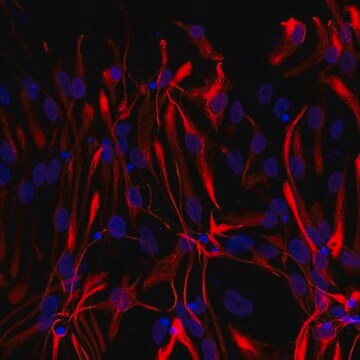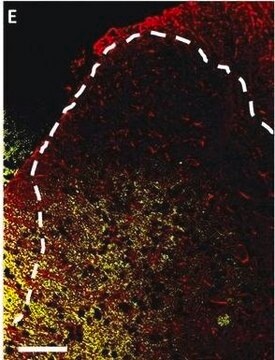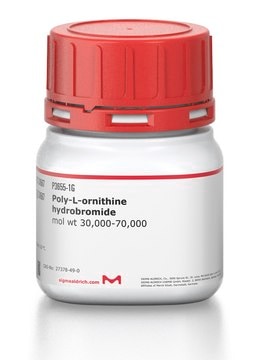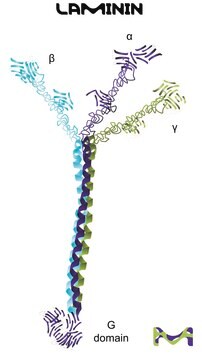추천 제품
제품명
Anti-Glial Fibrillary Acidic Protein Antibody, Chemicon®, from chicken
생물학적 소스
chicken
Quality Level
항체 형태
affinity isolated antibody
항체 생산 유형
primary antibodies
클론
polyclonal
정제법
affinity chromatography
종 반응성
human, mouse, rat, bovine, pig
제조업체/상표
Chemicon®
기술
immunocytochemistry: suitable
immunohistochemistry (formalin-fixed, paraffin-embedded sections): suitable
western blot: suitable
NCBI 수납 번호
UniProt 수납 번호
배송 상태
dry ice
타겟 번역 후 변형
unmodified
유전자 정보
human ... GFAP(2670)
일반 설명
Glial fibrillary acidic protein (GFAP) is a class-III intermediate filament. Type III intermediate filaments contain three domains, the most conserved of which is the rod domain. The specific sequence for this region of the protein may differ between the different intermediate filament genes for type III proteins, but the structure of the protein is highly conserved. GFAP is the main constituent of intermediate filaments in astrocytes and serves as a cell specific marker that distinguishes differentiated astrocytes from other glial cells during the development of the central nervous system. GFAP is also found in the lens epithelium, Kupffer cells of the liver, in some cells in salivary tumors and has been reported in erythrocytes.
특이성
Expected to cross-react with bovine and porcine.
Glial fibrillary acidic protein (GFAP). Reacts with both native and recombinant protein.
Other species have not yet been tested.
면역원
Purified bovine GFAP.
애플리케이션
Immunohistochemistry(paraffin):
Representative images from a previous lot. Pictures of Optimal Staining With Citrate Buffer Epitope Retrieval: Human Brain.
Immunocytochemistry:
1:200-1:1,000 on cells in tissue culture fixed for one minute in 3.7% formalin and one minute in -20°C methanol.
Western blot:
1:100-1:500 using ECL. Recognizes a band of 55 kDa. May also react with a band of 50 kDa.
Immunohistochemistry:
1:100-1:500 on frozen tissue sections. Suggested fixative is 4% paraformaldehyde.
Optimal working dilutions must be determined by the end user.
STAINING PATTERN:
The antibody stains sharply defined cytoplasmic filaments of astroglia cells in tissue culture. Stains processes of astrocytes in sections of brain tissues.
Representative images from a previous lot. Pictures of Optimal Staining With Citrate Buffer Epitope Retrieval: Human Brain.
Immunocytochemistry:
1:200-1:1,000 on cells in tissue culture fixed for one minute in 3.7% formalin and one minute in -20°C methanol.
Western blot:
1:100-1:500 using ECL. Recognizes a band of 55 kDa. May also react with a band of 50 kDa.
Immunohistochemistry:
1:100-1:500 on frozen tissue sections. Suggested fixative is 4% paraformaldehyde.
Optimal working dilutions must be determined by the end user.
STAINING PATTERN:
The antibody stains sharply defined cytoplasmic filaments of astroglia cells in tissue culture. Stains processes of astrocytes in sections of brain tissues.
This Anti-Glial Fibrillary Acidic Protein Antibody is validated for use in IC, IH, IH(P), WB for the detection of GFAP.
품질
Routinely evaluated by Western Blot on Mouse Brain lysates.
Western Blot Analysis: 1:1000 dilution of this lot detected glial fibrillary acidic protein on 10 μg of Mouse Brain lysates.
Western Blot Analysis: 1:1000 dilution of this lot detected glial fibrillary acidic protein on 10 μg of Mouse Brain lysates.
표적 설명
55 kDa
결합
Replaces: 04-1031; 04-1062
물리적 형태
Purified chicken polyclonal in buffer containing PBS containing 0.02% sodium azide.
저장 및 안정성
Stable for 1 year at -20°C in undiluted aliquots from date of receipt. Do not store in a self-defrosting freezer.
Handling Recommendations:
Upon first thaw, and prior to removing the cap, centrifuge the vial and gently mix the solution. Aliquot into microcentrifuge tubes and store at -20°C. Avoid repeated freeze/thaw cycles, which may damage IgG and affect product performance.
Handling Recommendations:
Upon first thaw, and prior to removing the cap, centrifuge the vial and gently mix the solution. Aliquot into microcentrifuge tubes and store at -20°C. Avoid repeated freeze/thaw cycles, which may damage IgG and affect product performance.
분석 메모
Control
Astrocytes, astrocytomas, neural stem cells.
Astrocytes, astrocytomas, neural stem cells.
법적 정보
CHEMICON is a registered trademark of Merck KGaA, Darmstadt, Germany
적합한 제품을 찾을 수 없으신가요?
당사의 제품 선택기 도구.을(를) 시도해 보세요.
Storage Class Code
10 - Combustible liquids
WGK
WGK 2
시험 성적서(COA)
제품의 로트/배치 번호를 입력하여 시험 성적서(COA)을 검색하십시오. 로트 및 배치 번호는 제품 라벨에 있는 ‘로트’ 또는 ‘배치’라는 용어 뒤에서 찾을 수 있습니다.
이미 열람한 고객
Tanycyte-like cells form a blood-cerebrospinal fluid barrier in the circumventricular organs of the mouse brain.
Langlet, F; Mullier, A; Bouret, SG; Prevot, V; Dehouck, B
The Journal of Comparative Neurology null
In vivo MRI analysis of an inflammatory injury in the developing brain.
Lodygensky, GA; West, T; Stump, M; Holtzman, DM; Inder, TE; Neil, JJ
Brain, behavior, and immunity null
Diffusion characteristics associated with neuronal injury and glial activation following hypoxia-ischemia in the immature brain.
Lodygensky, GA; West, T; Moravec, MD; Back, SA; Dikranian, K; Holtzman, DM; Neil, JJ
Magn. Reson. in Med. null
Increased atypical PKC expression and activity in the phrenic motor nucleus following cervical spinal injury.
Guenther, CH; Windelborn, JA; Tubon, TC; Yin, JC; Mitchell, GS
Experimental neurology null
Taurine in drinking water recovers learning and memory in the adult APP/PS1 mouse model of Alzheimer's disease.
Kim, HY; Kim, HV; Yoon, JH; Kang, BR; Cho, SM; Lee, S; Kim, JY; Kim, JW; Cho, Y; Woo, J; Kim, Y
Scientific Reports null
자사의 과학자팀은 생명 과학, 재료 과학, 화학 합성, 크로마토그래피, 분석 및 기타 많은 영역을 포함한 모든 과학 분야에 경험이 있습니다..
고객지원팀으로 연락바랍니다.


